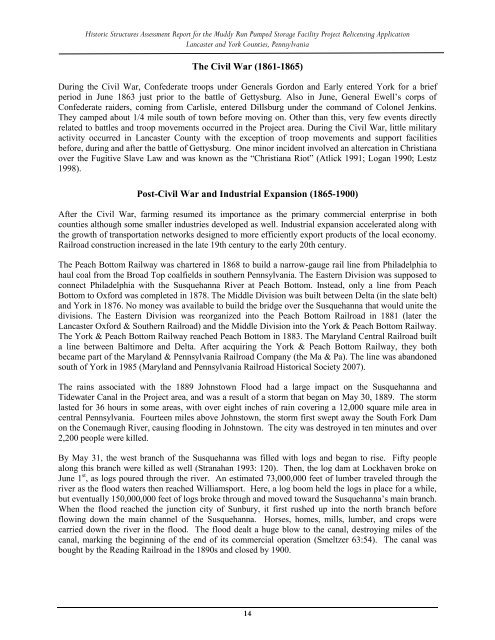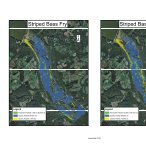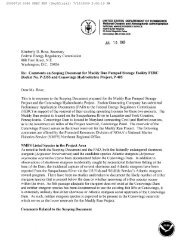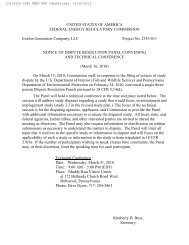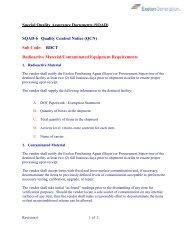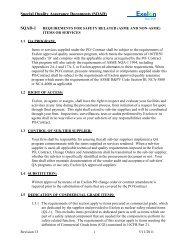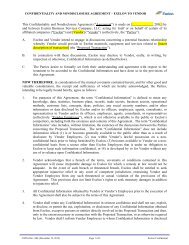Final Report Historical Structures Assessment Report for the Muddy ...
Final Report Historical Structures Assessment Report for the Muddy ...
Final Report Historical Structures Assessment Report for the Muddy ...
You also want an ePaper? Increase the reach of your titles
YUMPU automatically turns print PDFs into web optimized ePapers that Google loves.
Historic <strong>Structures</strong> <strong>Assessment</strong> <strong>Report</strong> <strong>for</strong> <strong>the</strong> <strong>Muddy</strong> Run Pumped Storage Facility Project Relicensing Application<br />
Lancaster and York Counties, Pennsylvania<br />
The Civil War (1861-1865)<br />
During <strong>the</strong> Civil War, Confederate troops under Generals Gordon and Early entered York <strong>for</strong> a brief<br />
period in June 1863 just prior to <strong>the</strong> battle of Gettysburg. Also in June, General Ewell’s corps of<br />
Confederate raiders, coming from Carlisle, entered Dillsburg under <strong>the</strong> command of Colonel Jenkins.<br />
They camped about 1/4 mile south of town be<strong>for</strong>e moving on. O<strong>the</strong>r than this, very few events directly<br />
related to battles and troop movements occurred in <strong>the</strong> Project area. During <strong>the</strong> Civil War, little military<br />
activity occurred in Lancaster County with <strong>the</strong> exception of troop movements and support facilities<br />
be<strong>for</strong>e, during and after <strong>the</strong> battle of Gettysburg. One minor incident involved an altercation in Christiana<br />
over <strong>the</strong> Fugitive Slave Law and was known as <strong>the</strong> “Christiana Riot” (Atlick 1991; Logan 1990; Lestz<br />
1998).<br />
Post-Civil War and Industrial Expansion (1865-1900)<br />
After <strong>the</strong> Civil War, farming resumed its importance as <strong>the</strong> primary commercial enterprise in both<br />
counties although some smaller industries developed as well. Industrial expansion accelerated along with<br />
<strong>the</strong> growth of transportation networks designed to more efficiently export products of <strong>the</strong> local economy.<br />
Railroad construction increased in <strong>the</strong> late 19th century to <strong>the</strong> early 20th century.<br />
The Peach Bottom Railway was chartered in 1868 to build a narrow-gauge rail line from Philadelphia to<br />
haul coal from <strong>the</strong> Broad Top coalfields in sou<strong>the</strong>rn Pennsylvania. The Eastern Division was supposed to<br />
connect Philadelphia with <strong>the</strong> Susquehanna River at Peach Bottom. Instead, only a line from Peach<br />
Bottom to Ox<strong>for</strong>d was completed in 1878. The Middle Division was built between Delta (in <strong>the</strong> slate belt)<br />
and York in 1876. No money was available to build <strong>the</strong> bridge over <strong>the</strong> Susquehanna that would unite <strong>the</strong><br />
divisions. The Eastern Division was reorganized into <strong>the</strong> Peach Bottom Railroad in 1881 (later <strong>the</strong><br />
Lancaster Ox<strong>for</strong>d & Sou<strong>the</strong>rn Railroad) and <strong>the</strong> Middle Division into <strong>the</strong> York & Peach Bottom Railway.<br />
The York & Peach Bottom Railway reached Peach Bottom in 1883. The Maryland Central Railroad built<br />
a line between Baltimore and Delta. After acquiring <strong>the</strong> York & Peach Bottom Railway, <strong>the</strong>y both<br />
became part of <strong>the</strong> Maryland & Pennsylvania Railroad Company (<strong>the</strong> Ma & Pa). The line was abandoned<br />
south of York in 1985 (Maryland and Pennsylvania Railroad <strong>Historical</strong> Society 2007).<br />
The rains associated with <strong>the</strong> 1889 Johnstown Flood had a large impact on <strong>the</strong> Susquehanna and<br />
Tidewater Canal in <strong>the</strong> Project area, and was a result of a storm that began on May 30, 1889. The storm<br />
lasted <strong>for</strong> 36 hours in some areas, with over eight inches of rain covering a 12,000 square mile area in<br />
central Pennsylvania. Fourteen miles above Johnstown, <strong>the</strong> storm first swept away <strong>the</strong> South Fork Dam<br />
on <strong>the</strong> Conemaugh River, causing flooding in Johnstown. The city was destroyed in ten minutes and over<br />
2,200 people were killed.<br />
By May 31, <strong>the</strong> west branch of <strong>the</strong> Susquehanna was filled with logs and began to rise. Fifty people<br />
along this branch were killed as well (Stranahan 1993: 120). Then, <strong>the</strong> log dam at Lockhaven broke on<br />
June 1 st , as logs poured through <strong>the</strong> river. An estimated 73,000,000 feet of lumber traveled through <strong>the</strong><br />
river as <strong>the</strong> flood waters <strong>the</strong>n reached Williamsport. Here, a log boom held <strong>the</strong> logs in place <strong>for</strong> a while,<br />
but eventually 150,000,000 feet of logs broke through and moved toward <strong>the</strong> Susquehanna’s main branch.<br />
When <strong>the</strong> flood reached <strong>the</strong> junction city of Sunbury, it first rushed up into <strong>the</strong> north branch be<strong>for</strong>e<br />
flowing down <strong>the</strong> main channel of <strong>the</strong> Susquehanna. Horses, homes, mills, lumber, and crops were<br />
carried down <strong>the</strong> river in <strong>the</strong> flood. The flood dealt a huge blow to <strong>the</strong> canal, destroying miles of <strong>the</strong><br />
canal, marking <strong>the</strong> beginning of <strong>the</strong> end of its commercial operation (Smeltzer 63:54). The canal was<br />
bought by <strong>the</strong> Reading Railroad in <strong>the</strong> 1890s and closed by 1900.<br />
14


